Russian troops will include mobile groups to combat enemy drones. Mobile teams to combat UAVs will be armed with ZU-23-2 automatic cannons mounted on truck chassis, as well as pickup trucks equipped with heavy machine guns. The new units will also include electronic warfare equipment and smoke production vehicles. The vehicles will cover objects with a smoke screen that is impenetrable to both optical-electronic systems and UAV thermal imagers. It is worth noting that such mobile groups have been operating within the Ukrainian army for quite a long time; they are used to cover various objects.
You are using an out of date browser. It may not display this or other websites correctly.
You should upgrade or use an alternative browser.
You should upgrade or use an alternative browser.
Russian Air Force (VVS)
- Thread starter Deino
- Start date
“The Kalashnikov Concern presented a new Russian UAV SKAT 350M. The drone is the result of a modernization of the well-proven Supercam 350 UAV, which often works in conjunction with the Lancet kamikaze drone; there is a video about all drones on the channel.
The UAV is designed for aerial surveillance, searching for objects in the optical and infrared ranges. The SKAT 350M UAV received a new design of the wing and control elements; its mechanical strength and reliability were improved. Many functions have been automated, an automatic operating mode has been introduced, and a new battery controller has been installed. A new target load has appeared, and technical solutions have been implemented to improve the functioning of daylight and thermal imaging cameras. A module with updated algorithms is also installed, providing target acquisition and tracking.
The SKAT 350M UAV is equipped with an electric motor and is capable of reaching speeds of up to 120 km/h with a range of up to 100 kilometers at altitudes of up to 2000 meters. The weight of the UAV is 15 kg, the flight time is up to 4 hours, it is launched from a catapult.
The UAV is designed for aerial surveillance, searching for objects in the optical and infrared ranges. The SKAT 350M UAV received a new design of the wing and control elements; its mechanical strength and reliability were improved. Many functions have been automated, an automatic operating mode has been introduced, and a new battery controller has been installed. A new target load has appeared, and technical solutions have been implemented to improve the functioning of daylight and thermal imaging cameras. A module with updated algorithms is also installed, providing target acquisition and tracking.
The SKAT 350M UAV is equipped with an electric motor and is capable of reaching speeds of up to 120 km/h with a range of up to 100 kilometers at altitudes of up to 2000 meters. The weight of the UAV is 15 kg, the flight time is up to 4 hours, it is launched from a catapult.
GoMig-21
Elite Member
- Oct 16, 2016
- 9,166
- 14,229
- Country of Origin

- Country of Residence

he cost of early versions of the Gadfly drone, without a homing system, is about 40 thousand rubles or 480 dollars.
I paid more for my Mavic Pro! lol And it doesn't have anything remotely close to this Square homing system. It does have a Return to Base capability which has come in very handy a few times on the boat when we lost sight of the thing and activated the auto return to base and the darn thing made it back to the boat safely, twice this happened.
I don't think I would need the homing aspect of this new system, but the search & track part would be great to have on recreational drones. In my case and many out there who like to boat & fish could use it to search for whales or sharks or large schools of fish near the surface.
Fatman17
THINK TANK: CONSULTANT
- Apr 24, 2007
- 36,877
- 43,249
- Country of Origin

- Country of Residence

THE RUSIAN ‘TANKBUSTER’
- Aviation Features
- THE RUSIAN ‘TANKBUSTER’
5th July 2018
FEATURE
The Sukhoi Su-25 ‘Frogfoot’ was developed as a rugged close air support aircraft. It too has been upgraded with modest projects to help keep it relevant for more modern campaigns.
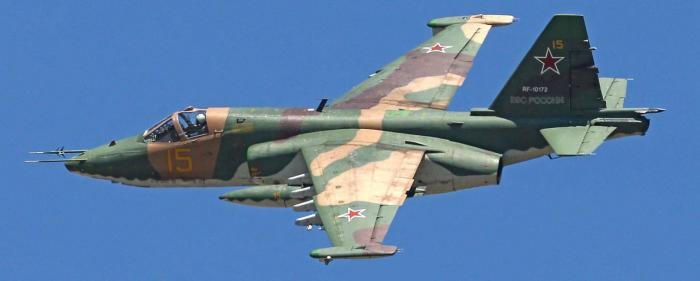
Around 130 Su-25s remain in Russian Aerospace Forces service and all are set to be upgraded to SM3 standard. Dmitriy Pichugin
THE SU_25 ‘FROGFOOT’ is a single-seat, heavily armored, subsonic close air support (CAS) aircraft. Early in the Syrian campaign, the Su-25 was, along with the Su-24, the most numerous aircraft in the Russian contingent in the country — 12 Su-25SM/ UB attack aircraft from the 960th Attack Aviation Regiment at Primorsko-Akhtarsk were initially stationed in Syria. Under the ‘first withdrawal’ of the Russian forces from Syria in March 2016, all the Su- 25s returned to Russia. Later, a handful returned to Syria, but never more than four jets. One may speculate that the Su-25s turned out to be much less useful there than the Su-24s and Su-34s. For example, the weapon loads carried by the Su-25s were surprising small. They usually flew with just four 250kg (551lb) bombs, although they are capable of carrying up to four tonnes of weapons.
The Su-25 began its combat career in Afghanistan. Two test aircraft, T8-1D and T8-3, were deployed to Shindand, Afghanistan, for trials in April 1980. In June 1981, the first full operational squadron of 12 aircraft was deployed there. During the Afghan war the Su-25 matured as a simple CAS aircraft that was rugged and resistant to enemy fire.
Afghan war experience heralded many changes in the design, including hydraulic boosters in the aileron control system to increase permitted speed from 459 to 540kt (850 to 1,000km/h), redesigned aerodynamic brakes on the wingtips to enhance their effectiveness, and additional infra-red decoy dispensers and armor plating to protect the engines. According to Sukhoi, Su-25s flew 60,000 sorties in Afghanistan and combat losses amounted to 23 aircraft.
It’s worth noting the weapons used in Afghanistan. The primary munition types used by the Su-25s were the cannon, bombs and unguided rockets. They employed guided missiles from April 1986 onwards, but in total they fired only 139 examples in this campaign.
Improved ‘Frogfoot’
The Su-25SM mid-life upgrade was initiated in 1999 with the aim of replacing the entire avionics suite with the new PrNK-25SM (Pritselno-Navigatsionnyi Kompleks, targeting and navigation complex) Bars, which is controlled by the SOI-U-25 (Sistema Obrabotki Informatsii i Upravleniya, data-processing and control system) with a BTsU-25 computer.
The KAI-1-01 head-up display replaces the original ASP-17 sight; a single MFTsI-0332M multi-function display is also added. The first upgraded aircraft, Su-25SM-1 ‘33 Red’, flew on March 5, 2002, and series upgrades started at the ARZ 121 repair plant at Kubinka in 2006.
The first six aircraft were handed over to the Russian Air Force on December 28, 2006. In total, four test and 80 operational aircraft were modernized to Su-25SM standard by 2014.
Su-25SM3
In 2014, the more advanced Su-25SM3 standard was emerging. Aircraft were slowly modified at Kubinka but were not delivered and instead awaited the completion of formal evaluations. Only in 2018 was the first batch of reportedly 22 upgraded Su-25SM3s delivered. Reports suggest that all surviving Su-25s will be upgraded to SM3 standard, including the Su-25SMs.
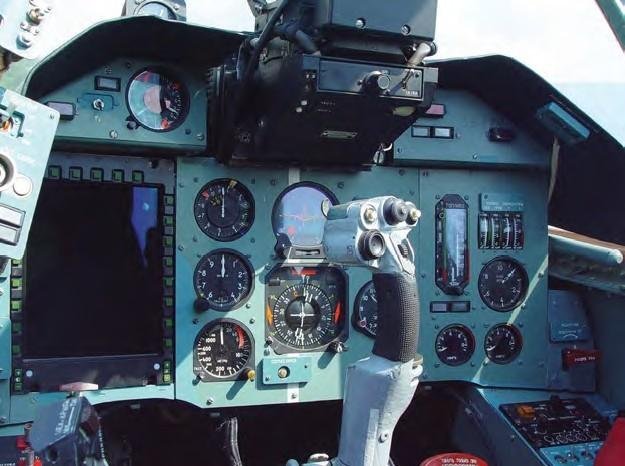
The cockpit of the upgraded Su-25SM features a new multifunction display. Piotr Butowski
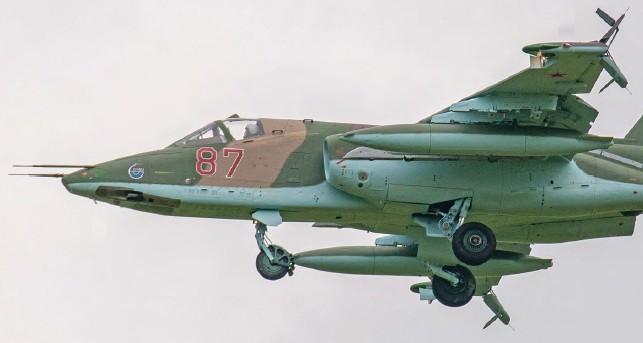
A Su-25SM, one of the 80 operational jets so modified. Piotr Butowski
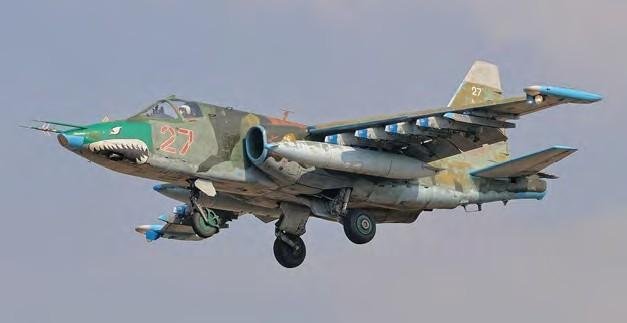
A wonderfully weathered Su-25 on final approach to land. The Su-25SM3 upgrade is now gathering pace. Piotr Butowski
The reason for the delay is attributed mainly to the SOLT-25 targeting system, which was not ready. Dividing the work into stages and adding the SOLT-25 later was considered, but eventually it was decided to wait.
The SOLT-25 (Sistema Optiko-Lazerno- Teplotelevizionnaya, optical-laserthermo- television system), produced by Zverev Zenith of Krasnogorsk, is fitted in the Su-25SM3’s nose in place of the basic Klyon-PS laser rangefinder/target designator. The Su-25SM3 also features the PrNK-25SM-1 targeting and navigation system that enables the simultaneous attack of four targets (compared with two in the SM version). The new L370K-25 Vitebsk-25 self-defense suite couples the Zakhvat infra-red sensor and L150-16M Pastel radar warning sensors, L370-3S active jammer in two pods on the wingtips, and a UV-26M decoy dispensing system. The UV-26M system controls the 26mm chaff/flares on the engine nacelles and 28 new 50mm downward-firing decoys fitted under the fuselage. A new KSS-25 communication suite is added too.
In comparison to the Su-25SM, the SM3 version adds Kh-58USh antiradiation missiles (up to two) and KAB-500S satellite-guided bombs (up to two). The remaining air-to-ground guided ordnance is similar to that of the Su-25SM and includes up to two Kh-29L/T/TD/TE missiles, up to two KAB-500Kr guided bombs and up to four Kh-25ML or S-25L/LD laserguided missiles. R-73 (AA-11 ‘Archer’) air-to-air missiles are carried for selfprotection. Two-seat upgraded aircraft are designated as the Su-25UBM2. An alternative SVP-24-25 upgrade from Gefest&T was tested but rejected.
In 2012, Sukhoi won a tender for the design of the Perspektivnyi Samolyot Shturmovik (PSSh, Future Attack Aircraft), codenamed ‘Shershen’ (hornet). It’s expected that the Sukhoi PSSh will be a development of the Su-25. The Ulan-Ude plant retains the infrastructure for Su-25 production, but the new project has stagnated.

A Su-25M lets rip with two S-25 heavy unguided rockets. Dmitriy Pichugin
Current status
Single-seat versions of the Su-25 were manufactured at the Tbilisi, Georgia, plant between 1979 and 1992, while two-seat examples came from the Ulan-Ude factory in Russia between 1987 and 1992. About 1,320 Su-25s were built and Russia currently has some 130 Su-25s in service with combat and training units, plus dozens more in storage. Other than the units listed in the table, re-establishment of two previously disbanded Su-25 regiments is planned. The first is the 266th Attack Aviation Regiment based at Step (Olovyannaya), 94nm (175km) southeast of Chita and approximately as far from the Chinese border. This base is now being thoroughly refurbished; the runway has been lengthened and the regiment will likely obtain Su-25s from Domna, which is being re-equipped with Su-30SMs. The other unit is the 899th Attack Aviation Regiment based at Buturlinovka, about 76nm (140km) from the Ukrainian border. This base is currently equipped with Su-34s while Voronezh is being refurbished.
Fatman17
THINK TANK: CONSULTANT
- Apr 24, 2007
- 36,877
- 43,249
- Country of Origin

- Country of Residence

OPERATIONAL Su-25 UNITS OF THE RUSSIAN AEROSPACE FORCES (VKS)

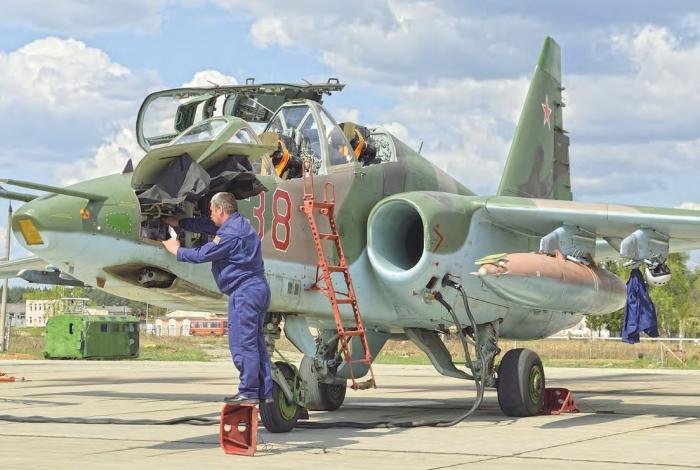
Su-25UB combat trainers were all built at the Ulan-Ude plant in Russia and are being upgraded to Su-25UBM2 standard. Piotr Butowski



Su-25UB combat trainers were all built at the Ulan-Ude plant in Russia and are being upgraded to Su-25UBM2 standard. Piotr Butowski

Originally published in Combat Aircraft Journal
The developers of the Russian kamikaze FPV drone "Gadfly" showed the communication repeater they created for drones. Communication relay for FPV drones allows you to significantly increase the operating range of FPV drones, bringing it to 30 km and above. The repeater has a 33-meter cable and a transmitter that allows you to work from a shelter; it has a signal conversion system that allows you to work with a wide range of ground-based equipment. Production is still on a small scale, about 10 pieces per day. Details in the video.
Russian developers of the kamikaze drone "Scalpel" described how they continue to improve the drone. Previously, we provided technical information about the Scalpel drone in the link to the video in the comments to the video. The "Scalpel" drone is a cheap analogue of the Russian kamikaze drone "Lancet", despite the fact that the drone is still being finalized, it is already being supplied to Russian troops to a limited extent. The drone's flight range is currently up to 40 km.
Two Tu-95ms strategic missile carriers of Russian long-range aviation performed a scheduled flight in the airspace over the neutral waters of the Bering Sea. The flight duration was more than 11 hours; the Tu-95MS strategic missile carriers were accompanied by Russian Su-30SM 4++ generation fighters. Off the west coast of Alaska, Russian Tu-95MS missile carriers were accompanied by F-16C fighters from the 18th Fighter Interceptor Squadron from Eielson Air Force Base in Alaska.
GoMig-21
Elite Member
- Oct 16, 2016
- 9,166
- 14,229
- Country of Origin

- Country of Residence

Two Tu-95ms strategic missile carriers of Russian long-range aviation performed a scheduled flight in the airspace over the neutral waters of the Bering Sea. The flight duration was more than 11 hours; the Tu-95MS strategic missile carriers were accompanied by Russian Su-30SM 4++ generation fighters. Off the west coast of Alaska, Russian Tu-95MS missile carriers were accompanied by F-16C fighters from the 18th Fighter Interceptor Squadron from Eielson Air Force Base in Alaska.
Looks like everyone behaved themselves there lol. That's a good thing considering the F-16 was carrying AMRAAMs and the Su-30SM had a pair of R-73s. But man did that SM look really sexy. and interesting camo on the F-16 almost looks like an Aggressor livery, but those ones from the 18th out of Alaska include the Artic Falcons, too.

The only Soviet combat fighter I-16, which participated in the battles of the Great Patriotic War, has been restored in Russia. There are now only three flying I-16 aircraft in the world. The I-16 fighter will take to the skies at the Victory Parade in Novosibirsk on May 9. The I-16 was developed in the design bureau of Nikolai Polikarpov. The I-16 aircraft is quite difficult to pilot; due to its tendency to go into a tailspin at low altitude, which leads to difficulties during landing, the aircraft did not make even the slightest mistakes in piloting. The first I-16 type 4 fighter was put into serial production in 1934, it became the most popular Soviet fighter, 10 thousand aircraft were manufactured before 1942, they were also used in Spain and China. The aircraft was equipped with engines with power starting from 480 hp. up to 1100 hp The aircraft is armed with 4 ShKAS machine guns of 7.62 mm caliber or 20 mm ShVAK air cannon. The plane carried 6 RS-82 shells or up to 500 kg of bombs. The maximum flight range of the I-16 is 680 km, at altitudes up to 9950 meters, at speeds up to 470 km/h.
GoMig-21
Elite Member
- Oct 16, 2016
- 9,166
- 14,229
- Country of Origin

- Country of Residence

Victory Parade in Novosibirsk on May 9.
Looking forward to the parade tomorrow. My son keeps reminding me as this is his favorite part.
Footage of the Russian Ka-52 helicopter piloting at ultra-low altitude. Judging by the instruments, the helicopter flies at a height of 2-3 meters with a speed of about 220 km/h. When flying at extremely low altitudes, it is necessary to continuously maintain visual orientation and constantly monitor the earth's surface and obstacles on it, which practically eliminates the possibility of using counting and measuring instruments.
Against the backdrop of news about the appointment of Andrei Belousov as Russian Minister of Defense, details have become known about the degree of localization of drone production in Russia. Despite the fact that they began to talk about the importance of developing the production of drones back in 2020 and began to intensively create production facilities for the production of components, the degree of localization of their production for 2023 is still low. Details in the video.
GoMig-21
Elite Member
- Oct 16, 2016
- 9,166
- 14,229
- Country of Origin

- Country of Residence

Footage of the Russian Ka-52 helicopter piloting at ultra-low altitude. Judging by the instruments, the helicopter flies at a height of 2-3 meters with a speed of about 220 km/h.
That is insane! Unbelievable that thing is.
Here's the HUD footage of the Su-35S that shot down a Ukrainian MiG-29 from 65km distance using what appears to be 2 RVV-SDs (r-77-1) X post says 3 missiles fired.
But if in fact the kill was scored (which Russians claim it did and supposedly have technical proof not visual which is fine), then this should be the record for longest range combat A2A kill for an advanced medium range air to air missile (AMRAAM).
From Turkish to English translation:
Russian Air Force's Su-35S fighter jet fires 3x medium-range R-77-1 air-to-air missiles at the MiG-29 fighter jet.
And here is a pretty good video on the success of the Su-35S in Ukraine and how it differs from the struggles of the Su-34. Some interesting points on the effectiveness of the Su-35S' maneuverability in dodging the Patriot missile. And who said the Su-35S was only good for airshows? Someone should have a chit-chat with that guy and show him this video.
Yommie
Elite Member
- Oct 2, 2013
- 56,027
- 36,737
- Country of Origin

- Country of Residence

Footage of the Russian Ka-52 helicopter piloting at ultra-low altitude. Judging by the instruments, the helicopter flies at a height of 2-3 meters with a speed of about 220 km/h. When flying at extremely low altitudes, it is necessary to continuously maintain visual orientation and constantly monitor the earth's surface and obstacles on it, which practically eliminates the possibility of using counting and measuring instruments.
I suppose it has an autopilot to prevent the helicopter accidentally hitting the ground in low altitude high speed flights.
Users who are viewing this thread
Total: 2 (members: 0, guests: 2)
Pakistan Defence Latest
-
-
-
PAF Very Own A2A Missiles [WVR, BVR & ALCM Stand off] News, Updates & Discussions (11 Viewers)
- Latest: CombatCorner
-
-
Country Watch Latest
-
-
-
India set to carry out trials for US-made Stryker combat vehicles in Ladakh & deserts (11 Viewers)
- Latest: Yasser76
-
-
